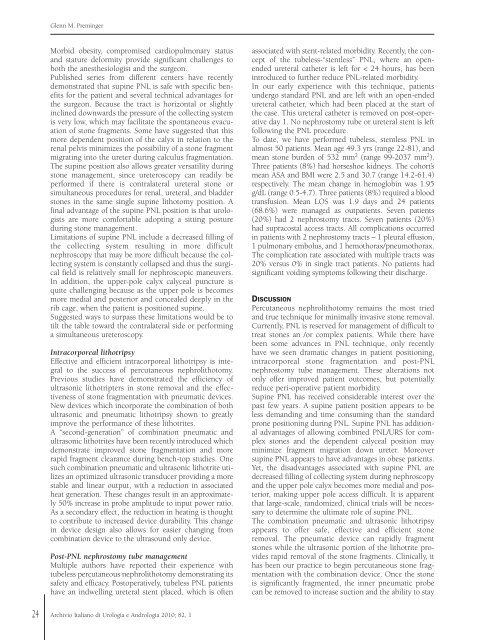Summary - Salute per tutti
Summary - Salute per tutti
Summary - Salute per tutti
- No tags were found...
You also want an ePaper? Increase the reach of your titles
YUMPU automatically turns print PDFs into web optimized ePapers that Google loves.
Glenn M. PremingerMorbid obesity, compromised cardiopulmonary statusand stature deformity provide significant challenges toboth the anesthesiologist and the surgeon.Published series from different centers have recentlydemonstrated that supine PNL is safe with specific benefitsfor the patient and several technical advantages forthe surgeon. Because the tract is horizontal or slightlyinclined downwards the pressure of the collecting systemis very low, which may facilitate the spontaneous evacuationof stone fragments. Some have suggested that thismore dependent position of the calyx in relation to therenal pelvis minimizes the possibility of a stone fragmentmigrating into the ureter during calculus fragmentation.The supine position also allows greater versatility duringstone management, since ureteroscopy can readily be<strong>per</strong>formed if there is contralateral ureteral stone orsimultaneous procedures for renal, ureteral, and bladderstones in the same single supine lithotomy position. Afinal advantage of the supine PNL position is that urologistsare more comfortable adopting a sitting postureduring stone management.Limitations of supine PNL include a decreased filling ofthe collecting system resulting in more difficultnephroscopy that may be more difficult because the collectingsystem is constantly collapsed and thus the surgicalfield is relatively small for nephroscopic maneuvers.In addition, the up<strong>per</strong>-pole calyx calyceal puncture isquite challenging because as the up<strong>per</strong> pole is becomesmore medial and posterior and concealed deeply in therib cage, when the patient is positioned supine.Suggested ways to surpass these limitations would be totilt the table toward the contralateral side or <strong>per</strong>forminga simultaneous ureteroscopy.Intracorporeal lithotripsyEffective and efficient intracorporeal lithotripsy is integralto the success of <strong>per</strong>cutaneous nephrolithotomy.Previous studies have demonstrated the efficiency ofultrasonic lithotripters in stone removal and the effectivenessof stone fragmentation with pneumatic devices.New devices which incorporate the combination of bothultrasonic and pneumatic lithotripsy shown to greatlyimprove the <strong>per</strong>formance of these lithotrites.A “second-generation” of combination pneumatic andultrasonic lithotrites have been recently introduced whichdemonstrate improved stone fragmentation and morerapid fragment clearance during bench-top studies. Onesuch combination pneumatic and ultrasonic lithotrite utilizesan optimized ultrasonic transducer providing a morestable and linear output, with a reduction in associatedheat generation. These changes result in an approximately50% increase in probe amplitude to input power ratio.As a secondary effect, the reduction in heating is thoughtto contribute to increased device durability. This changein device design also allows for easier changing fromcombination device to the ultrasound only device.Post-PNL nephrostomy tube managementMultiple authors have reported their ex<strong>per</strong>ience withtubeless <strong>per</strong>cutaneous nephrolithotomy demonstrating itssafety and efficacy. Posto<strong>per</strong>atively, tubeless PNL patientshave an indwelling ureteral stent placed, which is oftenassociated with stent-related morbidity. Recently, the conceptof the tubeless-“stentless” PNL, where an openendedureteral catheter is left for < 24 hours, has beenintroduced to further reduce PNL-related morbidity.In our early ex<strong>per</strong>ience with this technique, patientsundergo standard PNL and are left with an open-endedureteral catheter, which had been placed at the start ofthe case. This ureteral catheter is removed on post-o<strong>per</strong>ativeday 1. No nephrostomy tube or ureteral stent is leftfollowing the PNL procedure.To date, we have <strong>per</strong>formed tubeless, stentless PNL inalmost 50 patients. Mean age 49.3 yrs (range 22-81), andmean stone burden of 532 mm 2 (range 99-2037 mm 2 ).Three patients (8%) had horseshoe kidneys. The cohort’smean ASA and BMI were 2.5 and 30.7 (range 14.2-61.4)respectively. The mean change in hemoglobin was 1.95g/dL (range 0.5-4.7). Three patients (8%) required a bloodtransfusion. Mean LOS was 1.9 days and 24 patients(68.6%) were managed as outpatients. Seven patients(20%) had 2 nephrostomy tracts. Seven patients (20%)had supracostal access tracts. All complications occurredin patients with 2 nephrostomy tracts – 1 pleural effusion,1 pulmonary embolus, and 1 hemothorax/pneumothorax.The complication rate associated with multiple tracts was20% versus 0% in single tract patients. No patients hadsignificant voiding symptoms following their discharge.DISCUSSIONPercutaneous nephrolithotomy remains the most triedand true technique for minimally invasive stone removal.Currently, PNL is reserved for management of difficult totreat stones an /or complex patients. While there havebeen some advances in PNL technique, only recentlyhave we seen dramatic changes in patient positioning,intracorporeal stone fragmentation and post-PNLnephrostomy tube management. These alterations notonly offer improved patient outcomes, but potentiallyreduce <strong>per</strong>i-o<strong>per</strong>ative patient morbidity.Supine PNL has received considerable interest over thepast few years. A supine patient position appears to beless demanding and time consuming than the standardprone positioning during PNL. Supine PNL has additionaladvantages of allowing combined PNL/URS for complexstones and the dependent calyceal position mayminimize fragment migration down ureter. Moreoversupine PNL appears to have advantages in obese patients.Yet, the disadvantages associated with supine PNL aredecreased filling of collecting system during nephroscopyand the up<strong>per</strong> pole calyx becomes more medial and posterior,making up<strong>per</strong> pole access difficult. It is apparentthat large-scale, randomized, clinical trials will be necessaryto determine the ultimate role of supine PNL.The combination pneumatic and ultrasonic lithotripsyappears to offer safe, effective and efficient stoneremoval. The pneumatic device can rapidly fragmentstones while the ultrasonic portion of the lithotrite providesrapid removal of the stone fragments. Clinically, ithas been our practice to begin <strong>per</strong>cutaneous stone fragmentationwith the combination device. Once the stoneis significantly fragmented, the inner pneumatic probecan be removed to increase suction and the ability to stay24Archivio Italiano di Urologia e Andrologia 2010; 82, 1
















